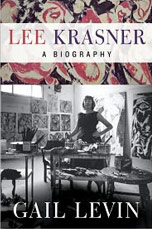Lee Krasner Out From Under Jackson Pollock’s Shadow
 Mostly outshone by the star power of her husband, painter Jackson Pollock, Lee Krasner was often discounted as an artist in her own right, and relegated to the difficult job of managing Pollock’s erratic behavior. But in the new book Lee Krasner: A Biography (William Morrow, 560pgs), art historian and biographer, Gail Levin, sheds new light on Krasner’s resilient personality and her creative talent. Born in Brooklyn in 1908, she went on to study art at Cooper Union and do work for the Federal Art Project of the Works Progress Administration during the 1920-30′s. With her intelligence and magnetism, Krasner rubbed shoulders with many of the artistic elite of the time, including Willem de Kooning and Stuart Davis. In 1941 she met Pollock and began to help nurture his talent and placate his demons.
Mostly outshone by the star power of her husband, painter Jackson Pollock, Lee Krasner was often discounted as an artist in her own right, and relegated to the difficult job of managing Pollock’s erratic behavior. But in the new book Lee Krasner: A Biography (William Morrow, 560pgs), art historian and biographer, Gail Levin, sheds new light on Krasner’s resilient personality and her creative talent. Born in Brooklyn in 1908, she went on to study art at Cooper Union and do work for the Federal Art Project of the Works Progress Administration during the 1920-30′s. With her intelligence and magnetism, Krasner rubbed shoulders with many of the artistic elite of the time, including Willem de Kooning and Stuart Davis. In 1941 she met Pollock and began to help nurture his talent and placate his demons.
Pollock’s personality was a turbulent mix of creative genius, narcissism and recklessness made more temperamental by his drinking. Krasner devotedly played a complex and stabilizing role in his life: part soothing mother, part attentive lover and part business promoter, despite his drunken belligerence and infidelities. Even after Pollock’s death in a car accident in 1956, she worked tirelessly to promote his work and talent, often at the expense of promoting her own art. It was not until the feminist movement of the 1970′s that the value of her worked was recognized.
In-depth knowledge of her subject and expansive research help author Levin paint an intimate and engrossing picture of Krasner. In a review for the The Boston Globe, Barbara Fisher applauds: “Levin…who knew Krasner as a friend and mentor, is an ideal biographer for her subject. Sympathetic yet scholarly, she inserts her own opinions or interpretations with great restraint and tact, relying on a vast amount of research. When she does insert herself, she does so in measured, thoughtful, succinct passages that explain, clarify or reconcile difficult pieces of personal, social, and intellectual history. She allows the portrait of Krasner to form itself slowly. In the end, a reader comes away with enormous respect for Krasner as a woman and a painter.”

